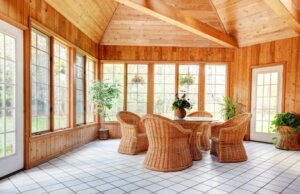Wall Wood Paneling - An Emerging Sophisticated Trend

Wall wood paneling might seem like an outdated fad, but it’s back and here to stay! Obviously, you can cover your walls in all types of different ways. However, it all depends on your personal tastes and what aesthetic effect you’re looking for. For this reason, below you’ll learn all about the sophistication of different types of modern wood paneling.
House walls are usually made of stone or brick. To hide them we usually apply a layer of plaster and paint, to produce an interesting and decorative appearance for the interior.
However, there are other options to make the space beautiful in a cordial, pleasant, and attractive way. Wood is a material that provides different ornamental solutions. Generally, people associate it with the furniture or floor, but why not use it on the walls as well?
Slatted wood paneling

Among the different types of wood paneling, some of the most common are long and smooth slatted panels. These can be found as horizontal or vertical. However, horizontal is the most popular.
It’s a simple and basic system – the panels fit together and can have a small gap between them or they can be placed together side by side. You’ll often find this covering in country and rustic houses.
You’ll enjoy the look of these warm and serene panels. Furthermore, they’ll help you achieve a more natural feel to the interiors and, at the same time, an elegance that surpasses all other construction materials.
A unique component for generating a more sophisticated environment.
3D relief paneling
A modern and alternative design is 3D relief paneling, which breaks with traditional approaches and produces a truly attractive optical effect since the modules protrude out of the wall.
It has a certain artistic image as if it were a piece of contemporary art. Its unusual appearance stands out from other construction techniques. Let’s look at some of its main characteristics:
- It consists of different wood panels, each one with a specific thickness to produce a relief effect. For that reason, some are deeper and others stick out. Some even cause a shadow effect.
- As a general rule, they’re commonly installed horizontally. However, there’s also the option of putting them vertically. The visual sensation you want to achieve will depend on you.
- As for the installation, it’s quite simple. By attaching each differently sized slat to the wall, it produces a 3D impression. By doing this, you’ll get a surprising result that’ll enrich the room and make it more dynamic.
- This style goes very well with modern design concepts – those that try to show a relaxed, sophisticated, and up to date appearance. It doesn’t really go well with classic or traditional designs.

Latticework
Lattices are another wooden covering that can occupy a large surface area. Their main characteristic is the mesh arrangement with oblique lines creating a compact framework. These are suitable for a terrace or garden.
You can use this to cover a concrete wall, while still being able to see the wall behind it. In fact, it’s useful for supporting a vine or for hanging plants. You can put some decorations on it, for fall or Christmas.
One of the features of this type of covering is that you can cut it and adapt it to any space. It has a basic and simple look while still being dynamic. You can integrate it into any project and, if desired, you can varnish it.
Sliding wood paneling
Finally, we’d like to highlight another idea that’s gaining more and more ground in the world of interior design: sliding panels. These are narrow panels that are separated from each other and have wheels so you can move the wall.
This system allows you to hide a part of the room and, on the other hand, helps decorate the entire room in a balanced way, without any mismatch. It’s functional as well as attractive.
All cited sources were thoroughly reviewed by our team to ensure their quality, reliability, currency, and validity. The bibliography of this article was considered reliable and of academic or scientific accuracy.
AA. VV.: Del suelo al techo: los revestimientos del hogar, Anaya, 2007.








